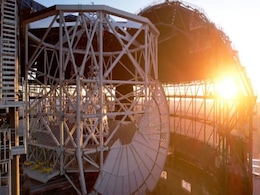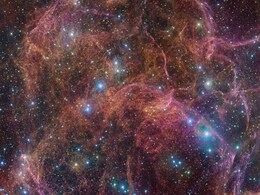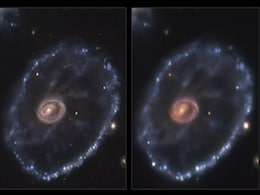European Southern Observatory
- All
- News
-

World’s Largest Telescope Dome Complete in Chile’s Atacama Desert
- Tuesday January 21, 2025
- Written by Gadgets 360 Staff
The construction of the Extremely Large Telescope (ELT) in Chile's Atacama Desert has reached a significant milestone with the completion of its dome's frame. The ELT, which will be the world’s largest visible- and infrared-light telescope, is being developed by the European Southern Observatory (ESO). The dome, measuring 305 feet in diameter and...
-
 www.gadgets360.com
www.gadgets360.com
-

Binary Star System D9 Found Orbiting Sagittarius A* Near Milky Way’s Core
- Thursday December 19, 2024
- Written by Gadgets 360 Staff
Astronomers have detected a young binary star system, D9, orbiting Sagittarius A*, the supermassive black hole at the Milky Way's centre. This challenges previous assumptions about star survival near intense gravitational forces. The discovery was made using the European Southern Observatory's Very Large Telescope. Future research with advanced tel...
-
 www.gadgets360.com
www.gadgets360.com
-

"Unprecedented Behaviour": Black Hole Observed 'Awakening' For The First Time
- Tuesday June 18, 2024
- World News | Agence France-Presse
Astronomers have been able to observe a supermassive black hole waking up and setting the heart of its host galaxy alight for the first time, the European Southern Observatory said on Tuesday.
-
 www.ndtv.com
www.ndtv.com
-

True Colours Of Uranus And Neptune Challenge Previous Assumptions
- Saturday January 6, 2024
- Science | NDTV News Desk
In a recent study, scientists used data from the Hubble Space Telescope and the European Southern Observatory's Very Large Telescope to reveal the true colours of the two ice planets.
-
 www.ndtv.com
www.ndtv.com
-

Two Planets Sharing The Same Orbit Around A Star? Astronomers Find Strong Evidence
- Thursday July 20, 2023
- World News | Edited by Anjali Thakur
The team spotted a cloud of debris that might be sharing the orbit of one of the two exoplanets known to orbit the young star PDS 70.
-
 www.ndtv.com
www.ndtv.com
-

Scientists Find Missing Link For Water On Earth, Say It's Older Than Sun
- Tuesday March 14, 2023
- Science | Edited by Amit Chaturvedi
Scientists said the study suggests that other planetary systems should have received large amounts of water too.
-
 www.ndtv.com
www.ndtv.com
-

ESO Releases Image of Aftermath of Large Star's Explosive Death
- Monday October 31, 2022
- Reuters
The aftermath of a large star's explosive death is seen in an image released on Monday by the European Southern Observatory, showing immense filaments of brightly shining gas that was blasted into space during the supernova. Before exploding at the end of its life cycle, the star is believed to have had a mass at least eight times greater than our ...
-
 www.gadgets360.com
www.gadgets360.com
-

Scientists Confirm Type II Supernova in Cartwheel Galaxy. See Photo
- Monday March 14, 2022
- Edited by Gadgets 360 Newsdesk
The European Southern Observatory (ESO) has captured an explosion occurring at the Cartwheel galaxy. The supernova, dubbed as SN2021afdx, has been identified as a Type II supernova.
-
 www.gadgets360.com
www.gadgets360.com
-

New Planet Discovered Orbiting Proxima Centauri, the Star Closest to Our Own Sun
- Friday February 11, 2022
- Edited by Gadgets 360 Newsdesk
The astronomers used the European Southern Observatory’s Very Large Telescope in Chile to spot this exoplanet
-
 www.gadgets360.com
www.gadgets360.com
-

Astronomers Discover Planet 10 Times Bigger Than Jupiter, Orbiting Pair of Giant Stars
- Friday December 10, 2021
- Edited by Gadgets 360 Newsdesk
A giant planet, 10 times the size of Jupiter and orbiting a pair of massive stars, has been discovered using the European Southern Observatory's Very Large Telescope.
-
 www.gadgets360.com
www.gadgets360.com
-

World’s Largest Telescope Dome Complete in Chile’s Atacama Desert
- Tuesday January 21, 2025
- Written by Gadgets 360 Staff
The construction of the Extremely Large Telescope (ELT) in Chile's Atacama Desert has reached a significant milestone with the completion of its dome's frame. The ELT, which will be the world’s largest visible- and infrared-light telescope, is being developed by the European Southern Observatory (ESO). The dome, measuring 305 feet in diameter and...
-
 www.gadgets360.com
www.gadgets360.com
-

Binary Star System D9 Found Orbiting Sagittarius A* Near Milky Way’s Core
- Thursday December 19, 2024
- Written by Gadgets 360 Staff
Astronomers have detected a young binary star system, D9, orbiting Sagittarius A*, the supermassive black hole at the Milky Way's centre. This challenges previous assumptions about star survival near intense gravitational forces. The discovery was made using the European Southern Observatory's Very Large Telescope. Future research with advanced tel...
-
 www.gadgets360.com
www.gadgets360.com
-

"Unprecedented Behaviour": Black Hole Observed 'Awakening' For The First Time
- Tuesday June 18, 2024
- World News | Agence France-Presse
Astronomers have been able to observe a supermassive black hole waking up and setting the heart of its host galaxy alight for the first time, the European Southern Observatory said on Tuesday.
-
 www.ndtv.com
www.ndtv.com
-

True Colours Of Uranus And Neptune Challenge Previous Assumptions
- Saturday January 6, 2024
- Science | NDTV News Desk
In a recent study, scientists used data from the Hubble Space Telescope and the European Southern Observatory's Very Large Telescope to reveal the true colours of the two ice planets.
-
 www.ndtv.com
www.ndtv.com
-

Two Planets Sharing The Same Orbit Around A Star? Astronomers Find Strong Evidence
- Thursday July 20, 2023
- World News | Edited by Anjali Thakur
The team spotted a cloud of debris that might be sharing the orbit of one of the two exoplanets known to orbit the young star PDS 70.
-
 www.ndtv.com
www.ndtv.com
-

Scientists Find Missing Link For Water On Earth, Say It's Older Than Sun
- Tuesday March 14, 2023
- Science | Edited by Amit Chaturvedi
Scientists said the study suggests that other planetary systems should have received large amounts of water too.
-
 www.ndtv.com
www.ndtv.com
-

ESO Releases Image of Aftermath of Large Star's Explosive Death
- Monday October 31, 2022
- Reuters
The aftermath of a large star's explosive death is seen in an image released on Monday by the European Southern Observatory, showing immense filaments of brightly shining gas that was blasted into space during the supernova. Before exploding at the end of its life cycle, the star is believed to have had a mass at least eight times greater than our ...
-
 www.gadgets360.com
www.gadgets360.com
-

Scientists Confirm Type II Supernova in Cartwheel Galaxy. See Photo
- Monday March 14, 2022
- Edited by Gadgets 360 Newsdesk
The European Southern Observatory (ESO) has captured an explosion occurring at the Cartwheel galaxy. The supernova, dubbed as SN2021afdx, has been identified as a Type II supernova.
-
 www.gadgets360.com
www.gadgets360.com
-

New Planet Discovered Orbiting Proxima Centauri, the Star Closest to Our Own Sun
- Friday February 11, 2022
- Edited by Gadgets 360 Newsdesk
The astronomers used the European Southern Observatory’s Very Large Telescope in Chile to spot this exoplanet
-
 www.gadgets360.com
www.gadgets360.com
-

Astronomers Discover Planet 10 Times Bigger Than Jupiter, Orbiting Pair of Giant Stars
- Friday December 10, 2021
- Edited by Gadgets 360 Newsdesk
A giant planet, 10 times the size of Jupiter and orbiting a pair of massive stars, has been discovered using the European Southern Observatory's Very Large Telescope.
-
 www.gadgets360.com
www.gadgets360.com
















